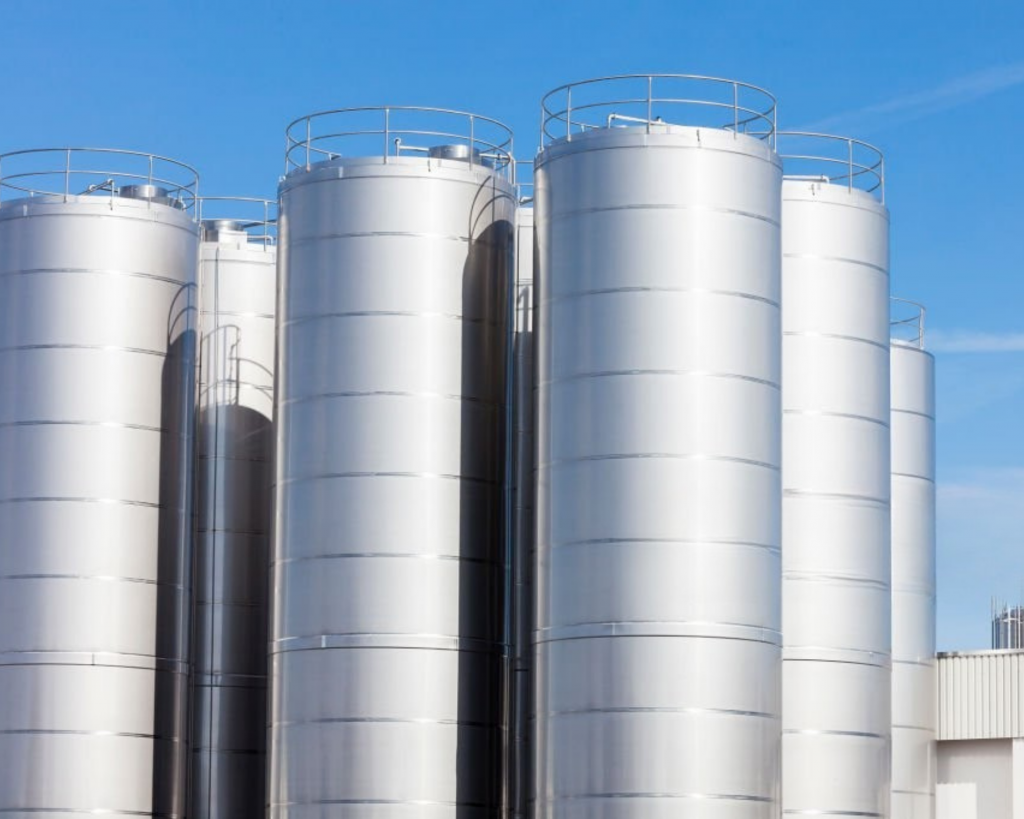Stainless Steel Tank Farm These systems combine multiple stainless steel tanks to store large volumes of liquids or chemicals. These systems are used in a wide range of applications, from food processing facilities to chemical plants.
These tank farms generally ensure the safe storage of liquid products for long periods of time, while also offering traceability through automated control systems. Their stainless steel construction ensures both hygienic conditions and increased durability.
Main Features:
High corrosion resistance
Long-lasting structure
Easy-to-clean surface
Precise control of liquid level
Resistance to environmental influences
Structure and Durability of Stainless Steel Tanks
Stainless steel tanks are generally Made of 304 or 316 quality steel This difference in quality is particularly important in terms of chemical resistance and resistance to harsh environments such as salt water.
Material Quality
304 Type:It is widely preferred in the food industry.
316 Type:Used in more harsh chemical environments and seafood storage.
Corrosion Resistance
One of the key advantages of stainless steel tanks is their high resistance to corrosion and rust, making them ideal for long-term investments.
Longevity
With proper maintenance, a stainless steel tank’s lifespan up to 30 years This means lower maintenance costs and long-term operating advantages.
Where is a Stainless Tank Farm Used?
Stainless tank farms play an active role in many different sectors:
Food Industry
Milk and dairy products storage
Fruit juice, beer and wine production
Confectionery and oils
Chemical Industry
Safe storage of acids, bases and solvents
Use as reaction tanks
Agriculture and Livestock
Liquid fertilizer and feed storage
Animal liquid waste management
Energy Sector
Biofuel storage
Geothermal and solar thermal fluid reserves
Tank Farm Planning and Layout
The most important step in a successful stainless tank farm installation is proper planning.
Space Requirement
Land planning should be based on the size of the tanks. Access roads, drainage systems, and fire safety areas should also be considered.
Layout and Security
Sufficient space must be left between tanks.
Emergency exit routes should be designed
Special insulation must be made for explosive materials
Installation Process Step by Step Guide
Needs Analysis:Which liquids will be stored and for how long is determined.
Permits and Documents:Local municipality and environmental permits are obtained.
Ground Preparation:Concrete floor and drainage infrastructure are established.Installation of Tanks:Placement and welding operations are carried out with cranes.
Connection and Testing:Pipe connections and leakage tests are performed.
Put in to use:Tanks are activated with automation systems.
Automation Systems and Technological Integration
Technological infrastructure is essential in modern stainless tank farms:
Level Sensors:Measures liquid amount in real time
Temperature Control:Compensates for temperature changes
Remote Monitoring:Control via web interface
These systems make production processes more efficient while minimizing human error.
Maintenance and Cleaning Procedures for Stainless Steel Tanks
Cleaning is of vital importance, especially in the food and chemical industries.
Routine Check
Weekly leak and corrosion check
Detailed maintenance once a year
Cleaning Methods
CIP (Clean-In-Place) systems
Internal surface cleaning with acid-base
Steam sterilization
Things to Consider When Installing a Stainless Steel Tank Farm
The smallest mistake made during the installation process can lead to serious costs and security problems in the future.
Security Precautions
A lightning rod system should be installed to protect tanks from lightning.
Appropriate extinguishing systems must be available against fire risk.
Automatic shut-off systems should be integrated to prevent overfilling and overflow risks.
Legal Regulations
Tank farms must comply with environmental legislation and TSE standards in Türkiye.
For food tanks ISO 22000 Attention should be paid to hygiene certificates such as:
Return on Investment Time
In a well-planned system, the return on investment is usually 3-5 years takes place between.
Comparison of Stainless Steel Tanks with Other Tank Types
Feature | Stainless steel | Plastic | Concrete | Carbon Steel |
Life | 30+ years | 5-10 years | 20 years | 10-15 years |
Cleaning | Easy | Medium | Difficult | Medium |
Hygiene | High | Low | Low | Medium |
Durability | High | Low | High | Medium |
Cost | High | Low | Medium | Medium |
Environmental Impacts and Sustainability
Stainless steel is environmentally friendly because it’s a recyclable material. It can also be integrated with energy-saving insulation systems.
Recyclability
100% recyclable
In line with the zero waste approach
Energy Efficiency
Cooling and heating costs are reduced with thermal insulation.
Can be integrated with solar energy systems
Quality and Warranty Processes
Production with at least 10 years of warranty
CE certificate and ISO quality management systems
Example 2: Marmara Chemical Company
Specially insulated tanks for chemical storage
15% energy savings were achieved thanks to remote monitoring systems
Conclusion and Future Perspective
Stainless Steel Tank Farm stand out as the investment of the future, both in terms of technological and environmental sustainability. Their food safety, chemical resistance, and long-term return on investment will continue to be the preferred choice in more and more sectors.
If you want to increase your industrial efficiency and have a long-lasting storage solution,stainless tank farminvestment may be the right choice for you.
Frequently Asked Questions (FAQ)
With proper care, it can last up to 30 years.
Yes, from a hygiene and regulatory standpoint, it is mandatory, especially for products such as milk and fruit juice.
CIP systems or manual steam cleaning.
Depending on the size of the project, it can take anywhere from 1 week to 3 months.
Level, temperature, and pressure sensors are the most commonly used.
It varies depending on the number and capacity of tanks; it starts from an average of 500 m².


